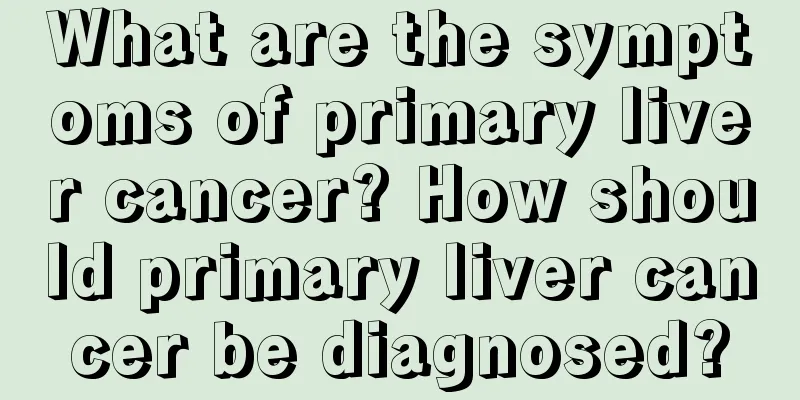What are the symptoms of primary liver cancer? How should primary liver cancer be diagnosed?

|
The clinical manifestations of primary liver cancer are extremely atypical, and the symptoms are usually not obvious, especially in the early stages of the disease. Usually, about 70% of small liver cancers under 5 cm are asymptomatic, and about 70% of asymptomatic subclinical liver cancers are also small liver cancers. Once symptoms appear, it means that the tumor has become larger, and the disease progresses rapidly, usually showing cachexia within a few weeks, and often dying from exhaustion within a few months to a year. The clinical symptoms are mainly two aspects of lesions: ① Manifestations of liver cirrhosis, such as ascites, collateral circulation, hematemesis and limb edema; ②Symptoms caused by the tumor itself, such as weight loss, general fatigue, pain in the liver area, and liver enlargement. When liver cancer develops to a certain stage, some clinical symptoms that are easily confused with hepatitis, cirrhosis, gastrointestinal tract, pancreatic and biliary system diseases may appear. The onset is often hidden, and liver cancer is often discovered accidentally during follow-up of liver disease or physical examination surveys using AFp and B-type ultrasound. At this time, the patient has no symptoms and the physical examination lacks signs of the tumor itself. This stage is called subclinical liver cancer. Once symptoms appear and patients come to the doctor, their disease course has mostly entered the middle and late stages. The clinical manifestations of liver cancer at different stages are significantly different. 1. The main clinical symptoms include pain in the liver area, abdominal distension, fatigue, poor appetite, weight loss, fever, jaundice, and progressive enlargement of the liver or upper abdominal mass. (1) Pain in the liver area: This is the most common and main clinical symptom. The pain is usually persistent dull pain, bloating or stabbing pain, which is more obvious at night or after fatigue. Pain in the liver area is caused by the rapid growth of the tumor, which increases the tension of the liver capsule, or the rupture of the cancer nodule under the capsule, or the rupture and bleeding of the liver cancer nodule. The location of pain in the liver area is closely related to the location of the lesion. If the lesion is located in the right lobe of the liver, it may manifest as right hypochondrium pain; if it is located in the left lobe of the liver, it may manifest as epigastric pain; if it is located behind the diaphragm, the pain may radiate to the shoulder and waist and back. If severe pain occurs suddenly and is accompanied by shock and other symptoms, it is mostly caused by the rupture of the cancer nodule and massive bleeding. (2) Poor appetite, nausea, and vomiting: These are often caused by liver damage or tumors compressing the gastrointestinal tract. Poor appetite is a common symptom. The more severe the condition, the more obvious the symptoms. (3) Abdominal distension: caused by large tumors, ascites, and liver dysfunction. Distension is more obvious in the upper abdomen, especially after eating and in the afternoon. Patients often reduce their food intake to alleviate symptoms, and are often mistaken for indigestion and not taken seriously, delaying diagnosis and treatment. (4) Fatigue and weight loss: caused by the metabolism of malignant tumors, excessive consumption, and lack of food intake. It may not be obvious in the early stage. As the disease progresses, the weight gradually decreases. In the late stage, the patient becomes extremely emaciated, anemic, exhausted, and cachectic. A small number of liver cancer patients with slower disease progression may also experience temporary weight gain after rest and supportive treatment. (5) Diarrhea: It is mainly caused by varying degrees of liver damage, which leads to a decrease in digestion and absorption capacity. It can also be caused by the metastasis of liver cancer cells to form portal vein cancer thrombus. Although this symptom is not very common, it can sometimes be the first symptom of liver cancer and is often misdiagnosed as a gastrointestinal infection. Diarrhea may not be accompanied by abdominal pain. It usually occurs after eating. The stool is mostly undigested food residues, often without pus or blood. Anti-inflammatory drugs cannot control it. In severe cases, the patient may have more than ten bowel movements a day, which can rapidly worsen the condition. (6) Fever: It is caused by tumor tissue necrosis, increased metabolic products, and tumor compression of the bile duct combined with cholangitis. In the absence of infection, it is called cancer fever, which is usually not accompanied by chills. Unexplained low-grade fever is a common symptom of liver cancer. The body temperature is generally between 37.5℃ and 38℃, but inflammatory diffuse liver cancer often has high fever, which can reach above 39℃. It is easy to be misdiagnosed as liver abscess. Antibiotic treatment is often ineffective, but indomethacin (indomethacin) can reduce fever. (7) Hematemesis and black stools: Hematemesis is mainly caused by liver cancer combined with liver cirrhosis, portal hypertension causing rupture of esophageal varicose veins and acute gastric mucosal lesions. Black stools are mainly caused by portal hypertensive gastropathy or peptic ulcer. Digestive tract bleeding caused by decreased coagulation function due to liver damage is rare. (8) Metastatic symptoms: Liver cancer can metastasize to the lungs, bones, pleura, gastrointestinal tract, and lymph nodes. Depending on the site of metastasis, it can cause corresponding symptoms, such as chest pain and hemoptysis in lung metastasis, and local pain and pathological fractures in bone metastasis. In addition, a few symptoms that are easily misdiagnosed may occur clinically. Some patients have small livers, and the clinical manifestations of ruptured liver cancer nodules are similar to cholecystitis. Some patients may be misdiagnosed as appendicitis because the rupture of the right liver cancer nodules is small and a small amount of blood slowly flows into the right lower abdomen. Other symptoms include bleeding tendency, such as gum and nose bleeding, which are related to damaged liver function, coagulation disorder and hypersplenism. 2. Common signs include progressive hepatomegaly, splenomegaly, jaundice, ascites, edema, liver palms, spider nevi, varicose veins of the abdominal wall, etc., which often appear in the late stage. (1) Progressive liver enlargement: This is the most common sign of liver cancer. When the liver protrudes under the right rib or xiphoid process, the upper abdomen may show localized bulge or fullness. The liver is hard, with an uneven surface, nodules or lumps of varying sizes, blunt and irregular edges, and often with varying degrees of tenderness. Right lobe liver cancer can cause the upper border of the liver to shift upward, and the liver is enlarged but without nodules under the ribs; right lobe liver cancer can often directly touch the mass, which often has a nodular feel; left lobe liver cancer may manifest as a mass under the xiphoid process, such as left lateral lobe liver cancer, with a more obvious notch on the right side of the mass. A blowing-like vascular murmur can be heard at the tumor site in the liver area, which is also a characteristic sign of liver cancer. Its mechanism of occurrence is due to the fact that the liver cancer arteries are rich and tortuous, the thick arteries suddenly become thinner, and (or) the hemodynamic changes caused by the compression of the hepatic artery and abdominal aorta by liver cancer nodules. (2) Jaundice: It usually occurs in the late stage, mostly obstructive jaundice, and a few are hepatocellular jaundice. Obstructive jaundice is often caused by cancer compression or invasion of the bile duct, or hepatocellular lymphadenopathy compression of the common bile duct, causing obstruction; hepatocellular jaundice can be caused by extensive infiltration of cancer tissue in the liver or combined with cirrhosis or chronic active hepatitis. (3) Portal hypertension: Liver cancer is often accompanied by liver cirrhosis or cancer invasion of the portal vein to form a tumor thrombus, both of which can increase portal vein pressure, resulting in a series of clinical manifestations of portal hypertension, such as ascites, splenomegaly, open collateral circulation, and exposed abdominal wall veins. Ascites grows rapidly, and bloody ascites is often caused by cancer invasion of the liver capsule or rupture of cancer nodules, and occasionally by peritoneal metastasis. In addition, there are spider nevi, liver palms, subcutaneous hemorrhage, male breast development, lower limb edema and other signs. Corresponding physical signs may appear at the site where liver cancer has metastasized, such as abnormal lung breath sounds and pleural effusion. The above symptoms and signs are not present in every patient with primary liver cancer. On the contrary, some cases often present with a few signs as their main manifestations, and are therefore often misdiagnosed as other diseases when admitted to the hospital. Understanding that liver cancer can present in different types of manifestations can reduce diagnostic errors. 3. Paraneoplastic syndrome Paraneoplastic syndrome refers to a group of syndromes caused by abnormal metabolism of the tumor itself or various effects of cancer tissue on the body in patients with primary liver cancer. The clinical manifestations are varied, and the more common ones are polycythemia, hypoglycemia, hypercalcemia, hyperfibrinogenemia, thrombocytosis, hypercholesterolemia, etc. Paraneoplastic syndrome is only seen in a small number of liver cancer patients. These symptoms sometimes appear before the local symptoms of liver cancer, and even become the first symptoms. If they can be recognized early, they can provide diagnostic clues and give liver cancer the opportunity to receive early treatment. At the same time, timely treatment of certain symptoms can help alleviate the patient's pain and prolong the patient's life. Therefore, it should attract the attention of clinical physicians. (1) Erythrocytosis: The incidence of hepatocellular carcinoma with erythrocytosis is about 2% to 10%. Peripheral blood leukocytes and platelets are often normal, bone marrow shows active erythroid proliferation, and the level of erythropoietin (EpO) in the body is often increased. Experiments have shown that EpO exists in the plasma of liver cancer cells, but not in adjacent liver cells and non-parenchymal cells; immunoelectron microscopy found that EpO reaction products can be seen in the endoplasmic reticulum of liver cancer cells, suggesting that they may be generated by liver cancer cells. Some people believe that the occurrence of erythrocytosis in patients with cirrhosis is a reliable indicator that liver cells tend to be malignantly transformed or liver cancer has occurred. (2) Hypoglycemia: 10-30% of patients may experience hypoglycemia, which is caused by the ectopic secretion of insulin or insulin-like substances by liver cells, or the inhibition of insulinase by tumors, or the secretion of a pancreatic β-cell stimulating factor, or excessive glycogen storage. It may also be caused by excessive glucose consumption by liver cancer tissue. Severe cases of this disease may lead to coma, shock, and death. Correct judgment and timely symptomatic treatment can save patients from death. Hypoglycemia is one of the common paraneoplastic syndromes of liver cancer. Foreign reports show that its incidence rate is as high as 300%, and it is often seen in patients with massive liver cancer. The mechanism of occurrence is: ① Liver cancer is often accompanied by cirrhosis, poor liver function, and decreased ability to regulate sugar metabolism, which may lead to hypoglycemia. ② Decreased liver function slows down insulin inactivation. ③ Liver cancer and adjacent liver cells can autosecrete insulin-like growth factors (IGFs) to promote lowering of blood sugar. (3) Hypercalcemia: Hypercalcemia is caused by the secretion of ectopic parathyroid hormone by liver cancer tissue. The clinical features are hypercalcemia and hypophosphatemia, which can be differentiated from bone metastasis of tumors. Liver cancer with hypercalcemia should be differentiated from primary hyperparathyroidism. When hypercalcemic crisis occurs, such as drowsiness, mental abnormalities, and coma, it is easy to be misdiagnosed as brain metastasis of liver cancer or hepatic encephalopathy, and should be taken seriously. (4) Hypercholesterolemia: Foreign reports show that the incidence of liver cancer with hypercholesterolemia is as high as 38%, and the pathogenesis is still unclear. According to the analysis of existing research data, it has the following characteristics: ① Massive liver cancer is more common; ② The changes in serum AFp and cholesterol are parallel. After surgical resection, the levels of serum AFp and cholesterol decrease consistently, and can increase consistently again when recurrence occurs. Therefore, serum cholesterol level can be used as a reference indicator for tumor recurrence in patients with liver cancer and hypercholesterolemia after surgical resection or hepatic artery embolization. (5) Thrombocytosis: Malignant tumors can cause secondary platelet increase. The cause of liver cancer with thrombocytosis may be related to the increase of thrombopoietin. After effective treatment such as surgery and hepatic artery embolization, the platelet count can be reduced. The characteristics of liver cancer combined with thrombocytosis are: ① The number of peripheral platelets increases, and most of the time it fluctuates between 400×109/L and 1000×109/L. ②Thrombosis and bleeding are rare. ③ Bone marrow images show an increase in megakaryocytes and platelets. (6) Hyperfibrinogenemia: Hyperfibrinogenemia in liver cancer has only been reported in individual cases, which may be related to abnormal protein synthesis in liver cancer. After surgical resection of the tumor, the fibrinogen level can be reduced to normal, while the level of patients whose tumors cannot be removed remains high. Therefore, the level of fibrinogen in the blood can be used as one of the markers for judging the efficacy of liver cancer surgery. Studies have found that patients with liver cancer who are 28p negative may have hyperfibrinogenemia. Therefore, for patients with unexplained elevated fibrinogen, even if AFp is negative, examinations and follow-up should be strengthened to exclude the possibility of HCC. Other manifestations of liver cancer paraneoplastic syndrome include increased calcitonin, carcinoid syndrome, hypertrophic arthritis and changes in sexual characteristics, but they are relatively rare. (7) Other systemic symptoms: Other rare symptoms include hyperlipidemia, hypercalcemia, carcinoid syndrome, early sexual intercourse and gonadotropin secretion syndrome, cutaneous porphyria and dysfibrinogenemia, which may be related to abnormal protein synthesis, ectopic endocrine secretion and porphyrin metabolism disorders in liver cancer tissue. 4. Classification: The overall clinical manifestations can vary greatly depending on the patient's age, the type of lesion, and whether or not there are other lesions such as cirrhosis. Generally, patients can be divided into four types: (1) Cirrhosis type: The patient originally had symptoms of cirrhosis, but recently developed liver pain, liver enlargement, liver function decline, etc.; or the patient recently developed symptoms similar to cirrhosis such as loss of appetite, anemia, emaciation, ascites, jaundice, etc., but the enlargement of the liver is not obvious. (2) Liver abscess type: The patient has obvious liver enlargement and significant liver pain. The disease develops rapidly and is accompanied by fever and secondary anemia, which is very similar to a single liver abscess. (3) Liver tumor type: This type is more typical. The patient was healthy but suddenly developed an enlarged liver and other symptoms. It is undoubtedly a malignant tumor. (4) Cancer metastasis type: Clinically, there are only manifestations of distant metastasis of the cancer, while the primary lesion is not obvious, and it is difficult to distinguish whether it is liver cancer or other cancers. Even if the liver is enlarged, it is often difficult to distinguish whether it is primary or secondary liver cancer. |
>>: What is the most common cause of primary liver cancer? How to treat primary liver cancer?
Recommend
Do wet towels have more bacteria than dry ones?
Towels are daily necessities that everyone needs....
How to make brine fragrant and tasty
The marinade has a great influence on the taste o...
What should patients with nasopharyngeal cancer eat to nourish their lungs? What should they pay attention to in their daily lives?
Nasopharyngeal cancer is already a common disease...
How to effectively treat snoring? It turns out there are these 7 ways
Snoring is a condition that many people experienc...
What should a pregnant woman do if she has breast cancer
Pregnancy and childbirth are special times for al...
How to detoxify the liver and gallbladder
Nowadays, most people stay up late, which will ma...
Cleaning the nose of a newborn baby after spitting up milk
After the baby spits up milk, the milk will alway...
Why can't I make a fist?
The inability to clench a fist is usually related...
Why do I have stomachache after eating?
Stomach pain after eating is a very common phenom...
Dandruff? Get rid of it!
Nowadays, many young and middle-aged people are t...
How is lung cancer detected
Lung cancer must be familiar to everyone. Since s...
Blisters after moxibustion are extremely itchy
Moxibustion is a relatively common Chinese medici...
How can I make my fingers thinner if they are thick
Everyone's fingers are different, some are wh...
The dangers of wearing a watch to sleep
In modern life, watches not only play the role of...
How to wash off the oil stains on down jackets
When there are oil stains on the down jacket, we ...









